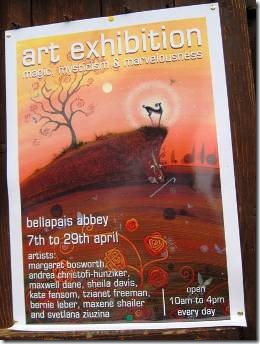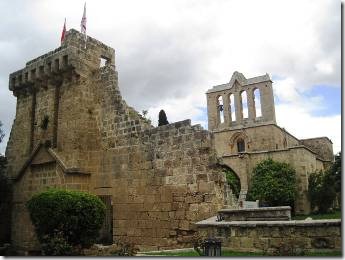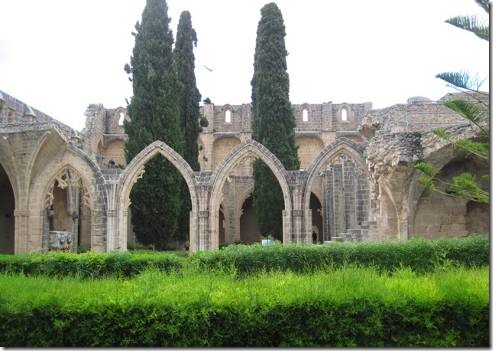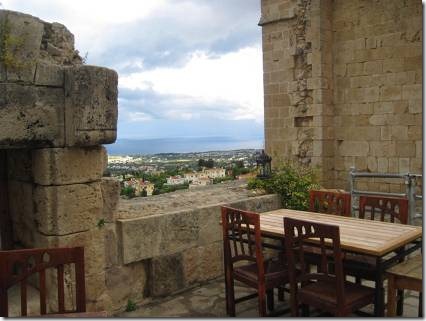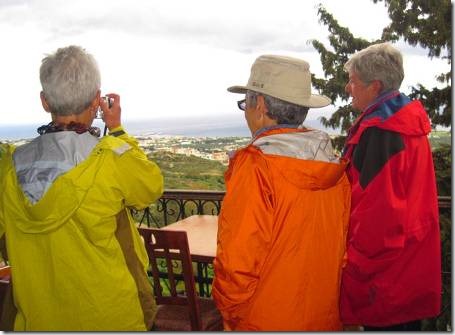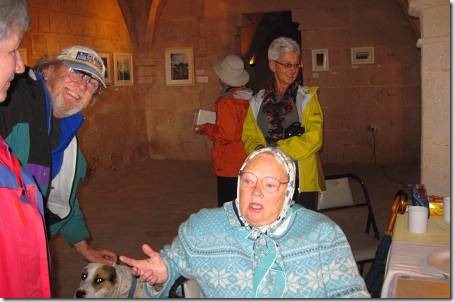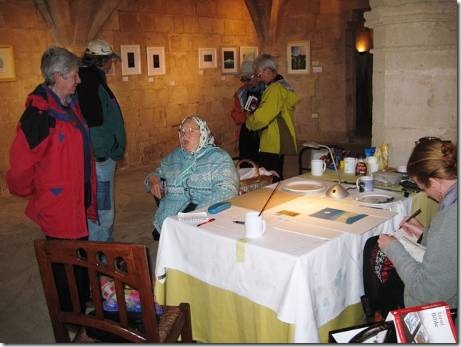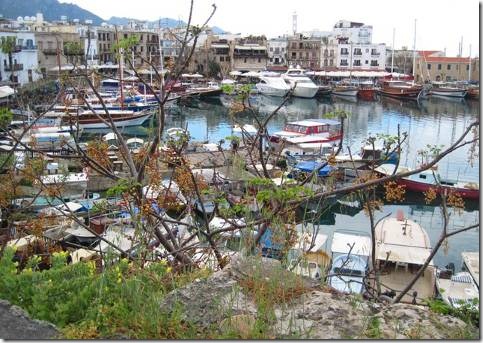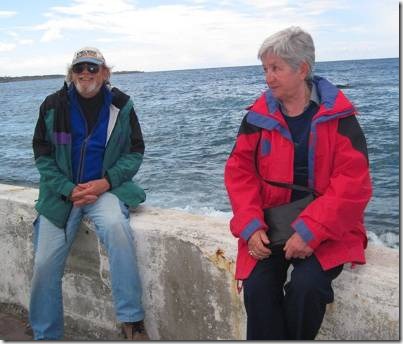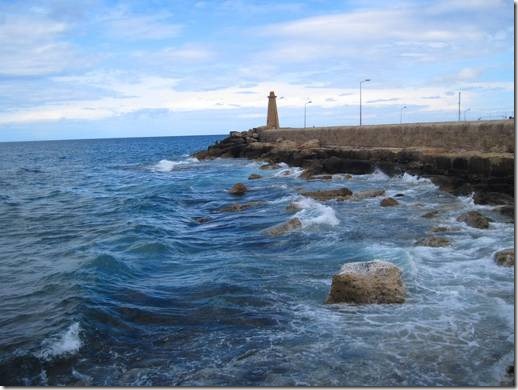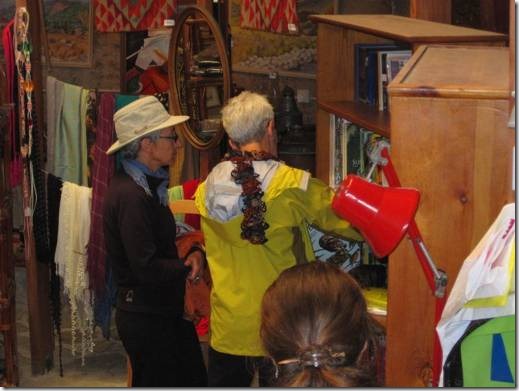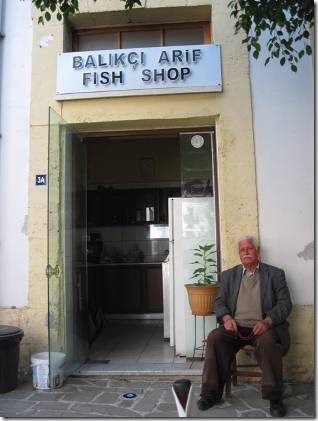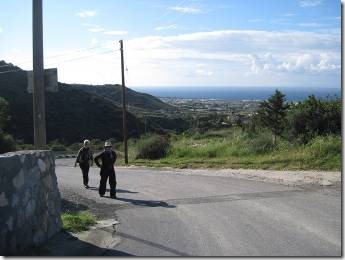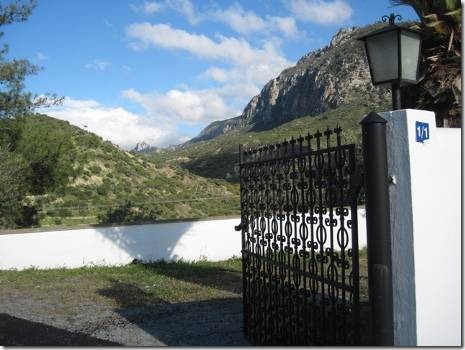There is so much to see here in Israel so Linda and Charmaine have extended their stay until June 5th! Tomorrow, Saturday and the Sabbath here in Israel, most places are closed. There is a sailing race that will take place and we will have front row seats on DoraMac at our new location in the marina. A new restaurant is opening and supposedly there is to be a loud party tonight but so far, all is quiet. We’ve had lots of people stop by asking about DoraMac. She appears to be quite the curiosity compared to a marina full of sailing boats or huge mega-yachts. Lots of compliments for her. Maybe tomorrow I can get more stories written and soon complete our Cyprus stories…..at least the ones we have had…maybe more some day!
Ru
Bellapais Abbey and Girne
Art Exhibition at Bellapais Abbey – Magic, Mysticism and & Marvelousness
I was familiar with the artwork of many of the artists exhibiting: all were friends of Heidi. It was definitely on my list of things to do while we were in the Girne area. And whom better to go with than Heidi Trautmann!
Any other time the Abbey would have been the star of the show; but our time was limited and we our main reason for coming was the art exhibit.
“ The site of Bellapais may have been the early residence of the Bishops of Kyrenia, as well as their refuge during the Arab raids of the 7th and 8th centuries.
In 1187, Jerusalem fell to the Saracens and the Augustinian canons who had custody of the Church of the Holy Sepulchre came to Cyprus. Bellapais Abbey was founded for them around 1200 by Aimery de Lusignan. It was consecrated as the Abbey of St. Mary of the Mountain.
The Augustians were soon followed by the White Canons or the Norbertines (also known as Premonstratensians), and this was the rule that was adopted from 1206 onwards. Their white habits gave Bellapais one of its names— it is referred to as the "White Abbey" in 15th and 16th century documents.
Roof and belfry of the abbey church, with mountain views. Photo: Nick Leonard.
In 1246, Sir Roger the Norman gave Bellapais Abbey a fragment of the True Cross and the sum of 600 besants, in exchange for the canons saying masses in perpetuity for his soul and that of his wife, Lady Alix.
The abbey also benefited from the generosity of Hugh III, who died in Tyre in 1284 and is believed to have been buried here. Hugh III gave the abbots of Bellapais the privilege of wearing a mitre, bearing a gilded sword and wearing golden spurs.
Thanks to its pious benefactors, Bellapais Abbey grew in size, importance and wealth. The powerful abbots were frequently in dispute with the Archbishop of Nicosia, and the pope had to intervene in disagreements on several occasions.
King Hugh IV lived in the abbey between 1354 and 1358 and added apartments for himself, but in 1373, Bellapais’ glittering treasure attracted the attention of the Genoese, who robbed the abbey of everything light enough to carry. After this, the abbey spun into physical and moral decline. By the mid-16th century, the strict Norbertine rule had been virtually abandoned at Bellapais, with many of the canons taking a wife (or two) and accepting only their own children as novices.
The Venetians shortened the long-standing name, Abbaye de la Paix (Abbey of Peace), to De la Paix, which eventually became Bellapais.
After the Turkish conquest in 1570, the abbey was given to the Orthodox Church. The buildings were neglected and fell into disrepair, but the abbey church was used as the parish church for the village that grew up around the monastery (presumably populated by descendents of the monks).
The grand old abbey impressed foreign visitors: in 1738, English traveller Richard Pococke remarked that he had seen at Bellapais "a most magnificent uninhabited convent… almost entire." When Captain Kinneir of the East India Company passed by in 1814, he saw cows grazing in the outer court.
The abbey fell further into disrepair over the years, its stone being used to build houses in the village. In 1878, the British Army cemented the floor of the great hall and used it for a military hospital. The ruins were repaired in 1912 by George Jeffery, Curator of the Ancient Monuments of Cyprus.
The best preserved of the abbey buildings is the refectory, on the north side of the cloisters. A magnificent room 30m long and 10m wide, the roof is supported by seven columns that look like they’re growing out of the side walls. It has six windows on the north wall that provide breathtaking views across the countryside to the sea, and a fine rose window high in the east wall. On the north wall is a projecting pulpit, from which a lector read from the scriptures or the lives of saints during mealtimes.
In the late 1800s, the British Army barbarically used the refectory as a shooting range, leaving bullet holes in the east wall. This impressive room is now used for concerts and lectures and hosts the local music festival in late May to early June.
Below the refectory is the undercroft, with decorative ceiling bosses. The cellarium and kitchens were to the west of the refectory, just a stone’s throw from the modern tables of the Kybele Restaurant.”
http://www.sacred-destinations.com/cyprus/bellapais-abbey.htm
Heidi’s favorite table at the restaurant at the Abbey.
All the colors of the rainbow!
http://www.heiditrautmann.com/category.aspx?CID=6487451176 is Heidi’s review of the art exhibit where you can see works by many of the participating artists.
It was a bit chilly in the undercroft below the refectory so Margaret is bundled up in her heavy wool sweater and scarf. An interesting factoid is that Connecticut born Margaret has a connection with the University of the Arts in Philadelphia where my nephew earned his Masters of Industrial Design and where he teaches classes as well as at the University of Pennsylvania and Parsons in NYC.
Margaret told us stories of her early years: Kate Fenson, pen in hand at the table, also shared the chore of manning the exhibit.
http://www.katefensom.com/katefensom/welcome.html is Kate’s website where you can read her fascinating bio and see more of her artwork. I didn’t find that Margaret has a website.
All too quickly we had to leave the abbey. Heidi wanted to show Linda and Charmaine a bit of Girne and we had to do it all and get home in time to rest and relax before our dinner reservation at 6 PM.
Looking at Girne’s old harbor.
Randal and Heidi relax on the wall while Charmaine and Linda walk along the stone harbor walls.
Girne Harbor
At the Round Tower where Charmaine bought her souvenir crocheted Cyprus scarf.
This gentleman wanted his photo taken so I obliged.
Then it was back to Heidi’s house for a walk up the hill towards Ilgaz before dinner.
As our friend Linda Levy wrote about Greece; if you want to see something “you gotta go up!” Same with lots of places in North Cyprus when you live at sea level.
What a wonderful view here!

